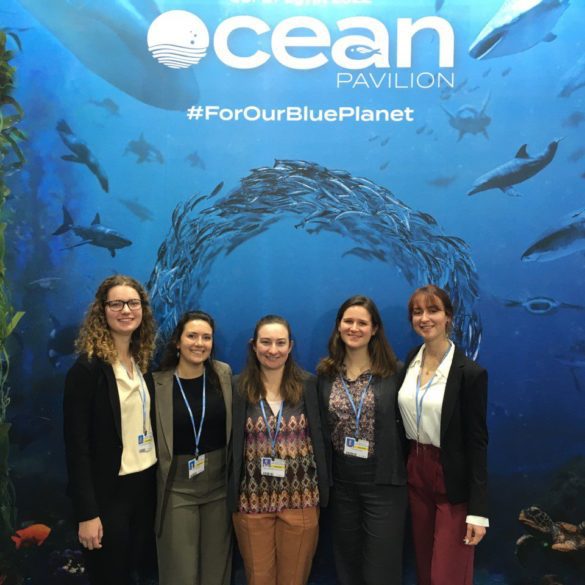By Dominic Fucile

MIT-WHOI JP students at Ocean Pavilion: L-R Ciara Willis (BIO), Brenna Boehman (MCG), Helena Cheslack (PO), Cora Hersh (PO), Shawnee Traylor (MCG). Photo provided by Danielle Fino.
Over 30 members of the WHOI community attended the Sharm el-Sheikh Climate Change Conference (COP27) in Egypt. From November 6 – 18 2022, WHOI administrators, scientists, and graduate students participated in the global discussion on climate.
The Institution’s presence was ten times larger than it was during last year’s Climate Change Conference. Included in this greater contingent were two teams from the MIT-WHOI Joint Program ‘Climate Change Science: Oceans, Cryosphere, and Climate’ course. Each group comprised of one faculty member and five graduate students. Both groups spent a week at the conference, with two days of overlap between them. The first group was led by Sarah Das, associate scientist in Marine Geology and Geophysics, and the second by Christopher Piecuch, associate scientist in the Physical Oceanography (PO) Department.
WHOI joined hundreds of Non-Governmental Organizations observing the conference. In conjunction with Scripps Institution of Oceanography, University of California, San Diego (UCSD) and 18 other science- and research-focused partner institutions, WHOI organized The Ocean Pavilion. 11 of the 61 sessions held at the Ocean Pavilion over the course of the Conference were led by WHOI.
The PO Department brought its own research and expertise, with various panels and presentations from many ongoing projects. One such presentation, on The Argo Float Program, was presented by Joint Program students Cora Hersh (PO) and Shawnee Traylor (Marine Chemistry and Geochemistry). A panel followed the presentation featuring PO senior scientists Carol Anne Clayson and Susan Wijffels, as well as experts from University California San Diego (UCSD), National Oceanic and Atmospheric Administration (NOAA), and the World Meteorological Organization (WMO).
“Argo really is a paradigm shift in accessibility to ocean data. These data are fully available within hours rather than the years it used to take to get access to ship-based data,” Hersh said. According to the presentation, roughly 5,600 scientific articles utilizing Argo data have been published to date.
Shawnee Traylor followed to summarize the Argo research and its importance to climate discussions. “To predict and prepare for the future climate, we must monitor the global ocean in real-time as much as possible.”
Further bringing physical oceanography into the discussion, a panel entitled “What’s at Risk: Defining Resiliency in a Rising Sea,” was moderated by Christopher Piecuch.
“I emphasize how relevant physical oceanography is on this stage… I think we can often miss just how relevant that the work we’re doing is in the world, even on this biggest climate conference in the world… Physical oceanography matters to these climate negotiations,” Piecuch said.
Many of the students within PO also recalled the great connections they made on the pavilion floor as well as the wide array of perspectives they were exposed to.
“They had an Egyptian climate activist that was only 17,” said Helena Cheslack, a student in the Joint Program, who was impressed by the wide breadth of topics and viewpoints presented. She also recalled the popularity of the Ocean Pavilion itself.
“It was very popular with everyone. There were a lot of young people interested in the Joint Program.”
The Ocean Pavilion stood alongside other booths representing other areas of climate interest. These included the Cryosphere Pavilion and the Resilience Hub. There were also booths representing various countries. This diverse set of groups was likened to an international “trade show or convention, but bigger and fancier” by PO joint program student Glenn Liu.
Piecuch also explained how these discussions related to the wider policy sessions at COP27.
“This is all going on in parallel with these sessions where policymakers are hashing out these big international agreements.”
COP27 resulted in a large collection of decisions addressing countries harmed by changing weather and climate as a result of human-caused emissions. The United Nations Framework Convention on Climate Change stated that in addition to reaffirming previous UN climate agreements, these decisions worked to “establish new funding arrangements, as well as a dedicated fund, to assist developing countries in responding to loss and damage.”
Even as COP27 came to a close, WHOI looked towards the future, as the institution has committed to returning for COP28 in the United Arab Emirates.
